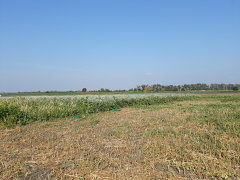Reduction of N and C emission into the air and shift of N into deeper layers of the soil by means of optimising the cultivation of green areas in arable farming
- Topic area
- Agriculture and forestry, incl. value chain
- Environment, biodiversity, nature conservation
- Climate protection and climate change
- Disaggregation level
- Agriculture
- Innovation
- Knowledge transfer
- Climate protection
- Water
- Biodiversity
- Environmental protection
- Value added
- Soil
- EIP European Innovation Partnership
- Project region
- Burgenland
- Carinthia
- Lower Austria
- Upper Austria
- Salzburg
- Styria
- Vienna
- LE– Programming Period
- LE 14–20
- Project period
- 01.05.2017-31.12.2020
- Project costs overall
- 558 223,43 €
- Priority
- EN - 16.02.1. Unterstützung bei der Entwicklung neuer Erzeugnisse, Verfahren & Technologien der Land-, Ernährungs- & Forstwirtschaft
- Project initiator
- ARGE Begrünung
Short description
Green areas reduce the shift of nitrogen into deeper layers of the soil as well as the gaseous N and C emissions and constitute an important measure for groundwater protection. In order to ensure that they fulfil this “catch-crop function” in an optimal way many factors have to be taken into consideration, from the establishment of green areas to the nutrient release from dead green plants, which have partly not yet been examined. The project “MinNC” aims at testing on the basis of practice-oriented trials measures aiming at the optimal management of greening and at evaluating their efficiency in terms of emission reduction. The results will be prepared for agricultural practice.
Point of departure
In some bodies of groundwater, in particular in East Austria, the groundwater shows high nitrate pollution due to intensive farming. Thus for example in the Marchfeld region a continuously rising tendency has been observed; the medium nitrate content of the groundwater amounting to 55mg/l NO3 between 2011 and 2015 was considerably above the permissible threshold value. Greening is a tool of ground water protection, because in autumn the green plants take up the residual nitrate from the soil and fix it in the plant biomass, so that it is not washed out in deeper soil layer during winter time. They constitute an important point within the framework of the Agri-environmental Programme ÖPUL, however, at the moment it is also possible to establish a type of greening which has only little benefit as catch crops for nitrogen. Within the framework of this project measures aiming at the reduction of emissions which are reasonable under the applicable conditions of the Austrian Agri-environmental Programme ÖPUL are tested. In this context it is examined under which conditions green plants fulfil their catch-crop function in an optimal way.
Targets and target groups
The project aims at improving the problem awareness for emissions in agricultural practice. Main target group are farmers who focus on arable farming.
Project implementation and measures
Important project steps are (1) planning and implementing practical experiments on arable areas of participating farmers over a period of three years taking into consideration the priority problem fields, (2) examinations of the nitrate content in the soil, of field emergence, of biomass and root behaviour of green plants, analysis of the N and C contents of soil samples and of above-ground and underground greening biomass and of the degradability of the greening biomass, of ground roughness and of the cost structure, (3) annual evaluations of field surveys and laboratory data and (4) the publication and dissemination of the results by field days, greening brochures, green plants compass etc.
Results and effects
An increased greening management with optimum cash-crop function has a variety of positive effects. Nitrogen is emitting to a lower extent into the groundwater and the atmosphere, but it remains in the soil and is available for the succeeding main crop. There is better carbon storage in the soil and an increased humus development. Particularly species-rich greening mixtures increase biodiversity. Last but not least silting and soil erosion are prevented in the case of severe events.

